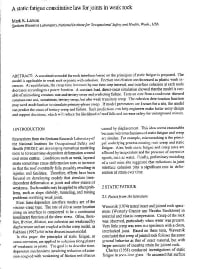Mining Publication: A Static Fatigue Constitutive Law for Joints in Weak Rock
Original creation date: April 1998
Authors: MK Larson
NIOSHTIC2 Number: 20000181
In Hans-Peter Rossmanith, ed. Proc Third Intl Conf on Mechanics of Jointed and Faulted Rock, Vienna, Austria; April 6-9, 1998, A.A. Balkema/Rotterdam/Brookfield; :171-177
A constitutive model for rock interfaces based on the principles of static fatigue is proposed. The model is applicable to weak rock or joints with cohesion. Friction and dilation are decreased as plastic work increases. At equilibrium, the creep time increases by one time-step interval, and interface cohesion at each node decreased according to a power function. A constant-load, direct-shear simulation showed that the model is capable of mimicking constant-rate and tertiary creep and predicting failure. Tests on core from a coal mine showed constant-rate and, sometimes, tertiary creep, but also weak transitory creep. The cohesion deterioration function may need modification to simulate primary-phase creep. If model parameters are known for a site, the model can predict the onset of tertiary creep and failure. Such predictions can help engineers make better entry design and support decisions, which will reduce the likelihood of roof falls and increase safety for underground miners.

NIOSHTIC2 Number: 20000181
In Hans-Peter Rossmanith, ed. Proc Third Intl Conf on Mechanics of Jointed and Faulted Rock, Vienna, Austria; April 6-9, 1998, A.A. Balkema/Rotterdam/Brookfield; :171-177
- Above-the-Earth Field Contours for a Dipole Buried in a Homogeneous Half-Space
- Degasification System Selection for U.S. Longwall Mines Using an Expert Classification System
- Determination of In Situ Deformation Modulus for Cemented Rockfill
- Diagnosing and Controlling Moisture-Sensitive Roof in Coal Mines
- Effects of Weak Bands on Pillar Stability in Stone Mines: Field Observations and Numerical Model Assessment
- Elastic and Shear Moduli of Coal Measure Rocks Derived from Basic Well Logs Using Fractal Statistics and Radial Basis Functions
- Numerical Model Calibration for Simulating Coal Pillars, Gob and Overburden Response
- Numerical Modeling of Paste Sills in Underhand Cut & Fill Stopes
- Pillar Strength and Design Methodology for Stone Mines
- Stochastic Modeling of Gob Gas Venthole Production Performances in Active and Completed Longwall Panels of Coal Mines